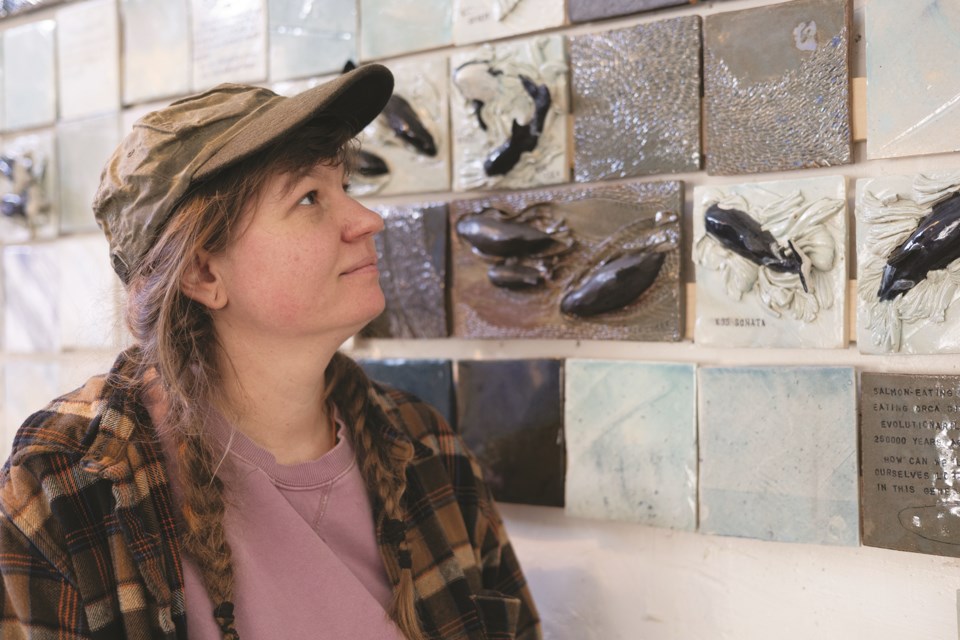The ceramic artworks that adorn the Gumboot Café in Roberts Creek until the end of this month are only steps from the source of their inspiration — the orca communities of the Salish Sea — and the studio of their creator, Clare Wilkening.
For Wilkening, who completed a university degree in environmental science before undertaking art studies at Emily Carr University, inspiration lies at the junction of the two disciplines.
“I was a horrible scientist,” she chuckled. “All my papers would be super illustrated and my teachers kept asking, ‘What are you doing here?’” After working in the film industry and enrolling in art school, she found a way to embody her ideas about ecology and science. “Ceramics,” she said, “is the perfect balance between something technical and expressive.”
At the heart of Wilkening’s showcase is her work Orca Tiles: 140 ceramic tiles depicting individual Southern Resident killer whales. Each orca is labelled with its name and pod membership. Markings on the dorsal fins that denote identity are rendered true-to-life. The experience of surveying an entire community — painstakingly rendered in moments of submerging, surfacing, travel and play — provokes visceral sensations of concern and kinship. For Wilkening, who has displayed her “lifelong project” over the last eight years, emotional stimulation is precisely the point.
“I’ve shown this work to hundreds of people now: at farmers’ markets, at scientific conferences, at galleries,” she said. “People will get emotional, will cry, will tell me their whale story. I’ve had people come back to see it, bringing four generations of their family, which is really beautiful because orcas themselves are so generational.”
Only 72 individuals remain in the South Resident orca subspecies after a history of being subjected to captivity, Wilkening explained, perpetrated by the aquarium- and consumer-led view of them as commodities instead of creatures with surprising parallels to human beings. Killer whales have family units. They express long-term care for each other.
“It’s not a foregone conclusion that they will go extinct,” added Wilkening, “but they are like a lot of things we need to change in order to avoid that happening. These [issues] need to be transformed into cultural material, not just a set of data, that gives people an opportunity to react or take action.”
Ecology is also at the heart of Wilkening’s botanical pottery, coloured and imprinted with the vibrant patterns of kelp leaves. She sees dishes and the nourishment they bear as linked expressions of love. Her clay vessels — she chooses the word vessels deliberately — can also be carriers of knowledge and existential significance.
Wilkening leads regular clay herring workshops, leading learners step-by-step through the functions of herring and other forage fish in the Salish Sea. She contrasts the millennia-long history of abundance with the contemporary “kill fishery” which decimates herring stocks. Meanwhile, participants fashion clay versions of the fish. “My mind,” she writes in her artist’s statement, “is in my hands.”
The stuff of life is an integral part of Wilkening’s clayworks (she varies her choice of clays and occasionally adds gravel or other textures). Now in the midst of completing a graduate degree in art and ecology, she is creating a tableware set that portrays the life cycle of salmon in a creek — contrasted with salmon in a farm setting. Its plates are made using molds Wilkening took from rocks in Roberts Creek’s spawning channel.
She plans to take the finished set on tour, inspiring conversations about the vital role of wild salmon in preserving orcas — and humans. While harvesting hundreds of mussels killed in 2021 by a summer heatwave (later used to make plaster molds for ceramic mussel formations), she concluded that making space for other species is a key to ecological abundance.
“Other animals are part of what makes us human,” she said. “We love them, we live with them, and they live with us.”
Wilkening’s works at the Gumboot Café remain on display until Feb. 28. She is also the filmmaker behind 2018’s Sturgeon Bank & Orca (youtube.com/watch?v=t2kELjb-DCw) and 2024’s Whales Forever, made in partnership with the locally-founded environmental organization The Jellyfish Project (thejellyfishproject.org/active-hope).




